SHRUBS > MAHONIA
Reviewed By DAN ORI

Dan has over 27 years’ under his belt caring for plants and gardens. Working as a Horticultural Instructor and Consultant, he draws on a diverse range of experience that includes working as a Head Gardener, Tree Surgeon, Garden Centre Trouble Shooter, and writer of academic papers. Dan has a Level 3 Diploma in Horticulture and is currently a candidate for the RHS’s most prestigious award – The Master of Horticulture.
IN THIS GUIDE
MAHONIA GUIDES
Mahonia is an evergreen shrub, with spiky dark green leaves, clusters of yellow flowers and purple or black berries.
The plant is late-flowering, meaning that it will not produce its pretty yellow blooms until late autumn and winter.
This makes it a great choice for adding colour to your garden later in the year, long after most spring and summer flowering plants have wilted.
There are several species of Mahonia, many of which are easy to grow in the UK.
It can thrive in sun or shade and does well in all soil types, so it’s an excellent choice for the trickier areas of your garden.
Overview
| Botanical Name | Mahonia |
| Plant Type | Shrub |
| Native Area | North / Central America & Asia |
| Hardiness Rating | H5 |
| Foliage | Evergreen, spiked glossy leaves |
| Flowers | Bright yellow spires |
| When To Sow | February, March, October, November |
| Flowering Months | January, February, March |
Sunlight
Preferred
Full Sun or Partial Shade
Exposure
Exposed or Sheltered
Size
Height
2.5 – 4M
Spread
1.5 – 2.5M
Bloom Time
January – March
Soil
Preferred
Most Soil Types
Moisture
Moist but well drained or well drained
pH
Any
The Mahonia genus is part of the Berberidaceae family.1Colin, O., Hinsinger, D., & Strijk, J. (2021, January 27). Mahonia lancasteri (Berberidaceae), a new species originating from Sichuan (China) described from cultivation. Phytotaxa. Retrieved March 21, 2023, from https://www.biotaxa.org/Phytotaxa/article/view/phytotaxa.482.1.5
There are around 70 species, including Mahonia japonica, and the Mahonia x media group, which includes the popular ‘Charity’ and ‘Winter sun’ varieties.2Mahonia. (n.d.). Royal Horticultural Society. Retrieved March 21, 2023, from https://www.rhs.org.uk/plants/mahonia
All varieties grow to different sizes – the most popular species in the UK are upright and bushy, and range from 1-5m in height, with a spread of up to 3m.
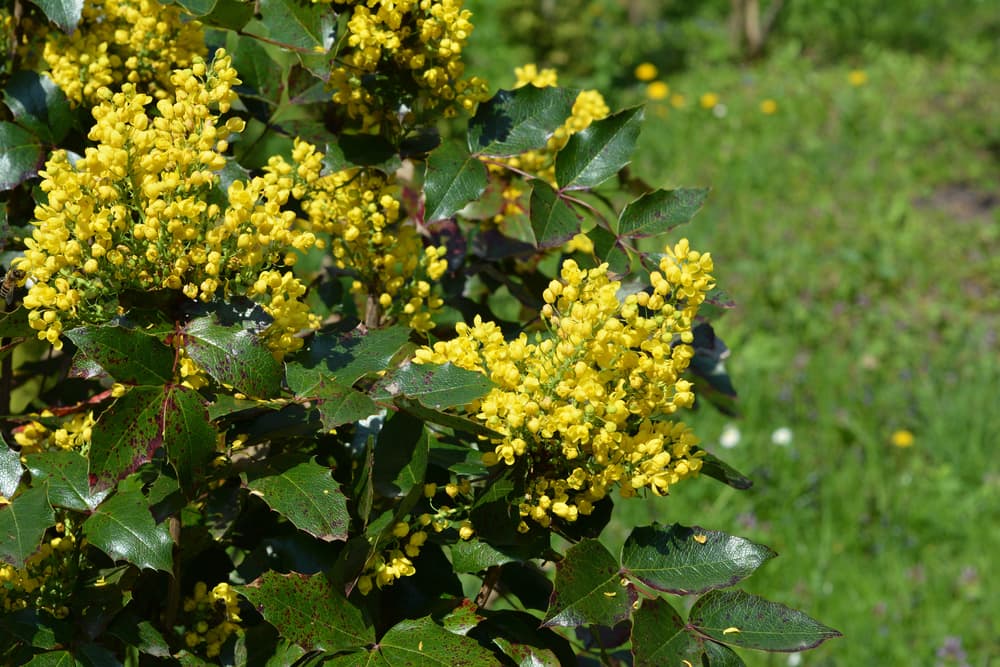
However, there are also some varieties which grow low to the ground at around 30cm tall, and which are suitable for use as ground cover.
Mahonia generally flowers in late autumn and winter, from November to March.
The flowers are usually yellow, but occasionally red, and appear in clustered racemes.
They are sometimes scented and can be followed by the production of purple or blackberries.

Due to their late flowering period, Mahonia is a popular choice for garden borders, alongside other evergreen shrubs such as Rhododendron, or plants such as snowdrops, to provide further winter colour.
Larger varieties, such as Mahonia ‘Charity’, are also often used as hedges and screening, where their thick and spiky nature makes them particularly effective at keeping out intruders.
They are also seen in public areas, such as on roundabouts.
Another name for Mahonia aquifolium is Oregon grape, which comes from the fact that Oregon adopted Mahonia as its state flower in 1899, and that the appearance of Mahonia berries is similar to that of black grapes.3Oregon State symbols. (n.d.). Oregon Encyclopedia. Retrieved March 21, 2023, from https://www.oregonencyclopedia.org/articles/oregon_state_symbols/#.ZBmm3uzP30o
Habitat & Growing Conditions
Mahonia’s natural habitat includes North America and Central America, as well as Asia and the Himalayas.4Teeling, C. (2022). Mahonia aquifolium (Oregongrape). CABI Compendium. https://doi.org/10.1079/cabicompendium.32269
It is often found growing in woodland and woodland edge locations, which is the reason it thrives in full and partial shade.
The plant is hardy, and can survive temperatures down to -15°C.

It has a low nutrient requirement, which means it grows in all types and pHs of soils, and although it prefers moist, well-drained soil, it can survive periods of drought.
“I find Mahonia a useful shrub for under the outer canopy of trees due to their tolerance of dry shady conditions,” says Master Horticulturist Dan Ori.
“I like to plant other yellow flowering plants nearby that tolerate the same conditions and overlap the flowering period like Jasminum nudiflorum (winter jasmine) and Narcissus ‘Rijnveld’s Early Sensation’ (early daffodil).”
How To Grow Mahonia
You can buy the most popular varieties of Mahonia in garden centres in the UK, or from online retailers.
The varieties that are most widely available include M. japonica, M. x media ‘Charity’, M. x media ‘Winter sun’ and M. aquifolium.
These will usually be available to purchase in pots, as plants of around 50cm tall.
Other varieties that are available in the UK, but less widely so, include M. eurybracteata ‘Soft Caress’, which grows to a height of 1m – and M. nitens ‘Cabaret’, which produces unusual orange-red flowers but is not as hardy.
When To Plant
The best time to plant a Mahonia is generally considered to be spring or autumn, when the weather is neither too hot nor too cold.
When planting, you should first soak the root ball in water for half an hour, to ensure it is moist.
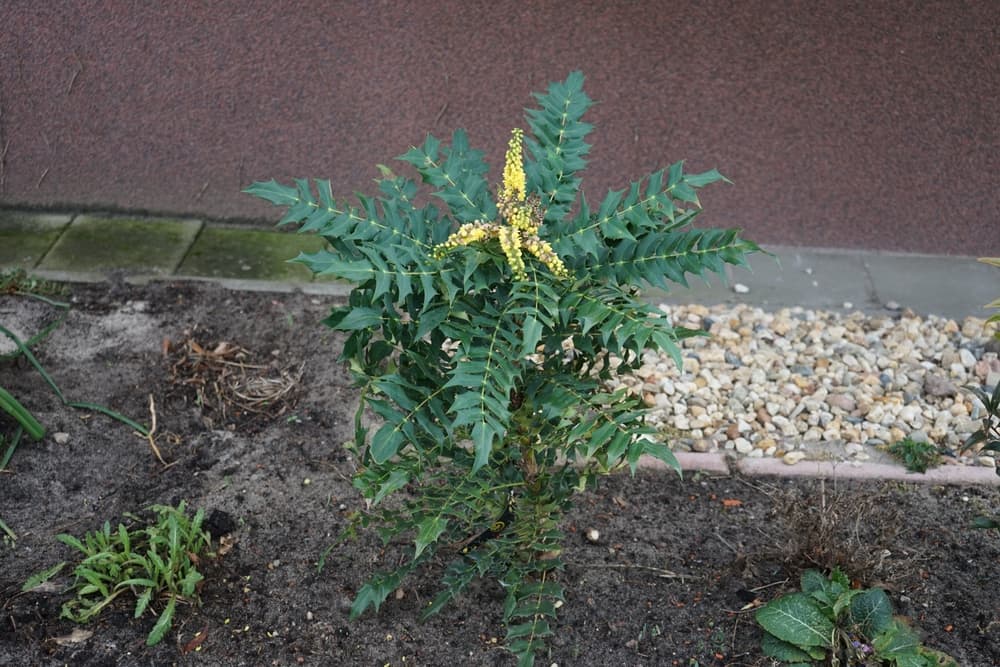
Add a small blood, fish and bone meal upon planting, to encourage new root growth.
How To Plant
To plant your Mahonia, you should dig a hole twice the size of the root ball.
It’s not a good idea to plant the roots dry, so soak the roots in a bucket of water for 30 minutes prior to planting.
You will need to make sure your Mahonia plant has enough space around it to grow, as they do not do well in crowded conditions.
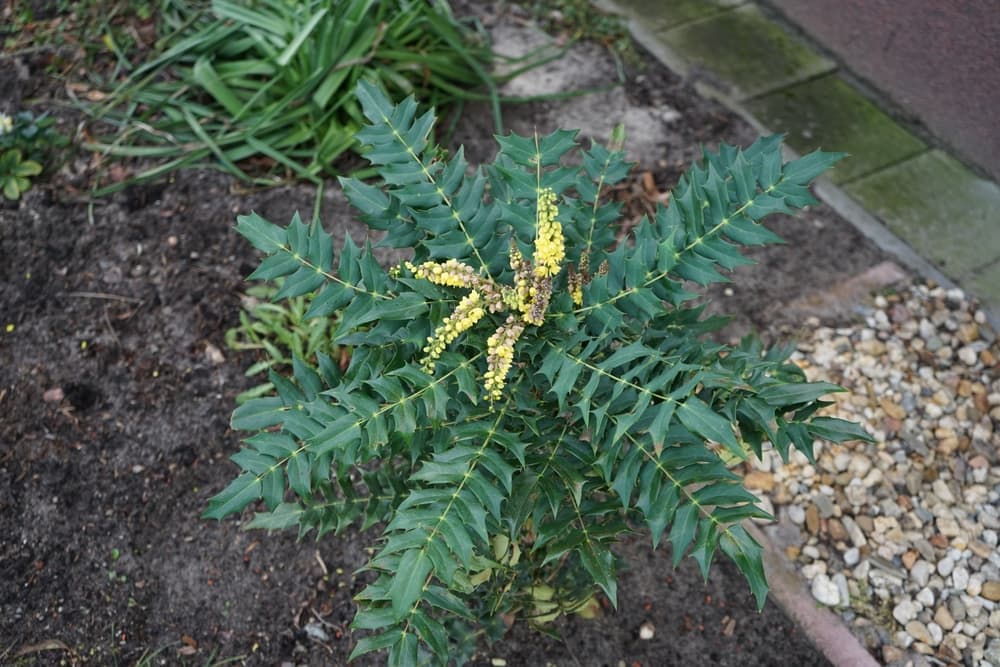
Exactly how much is required depends on the variety and the size of its ultimate spread.
Place the plant in the hole, fill it in with compost, and feed with blood, fish and bone meal (avoid high-nitrogen plant foods).
Water upon planting, and frequently whilst growing, although do not allow the ground to become waterlogged.
Once established, the plant will require very little watering, and you should only need to water it during extremely hot, dry periods.
Plant Care
Mahonia is a hardy plant and is therefore relatively easy to look after.
Sunlight
It can grow in full sun, but it prefers partial shade or even full shade.
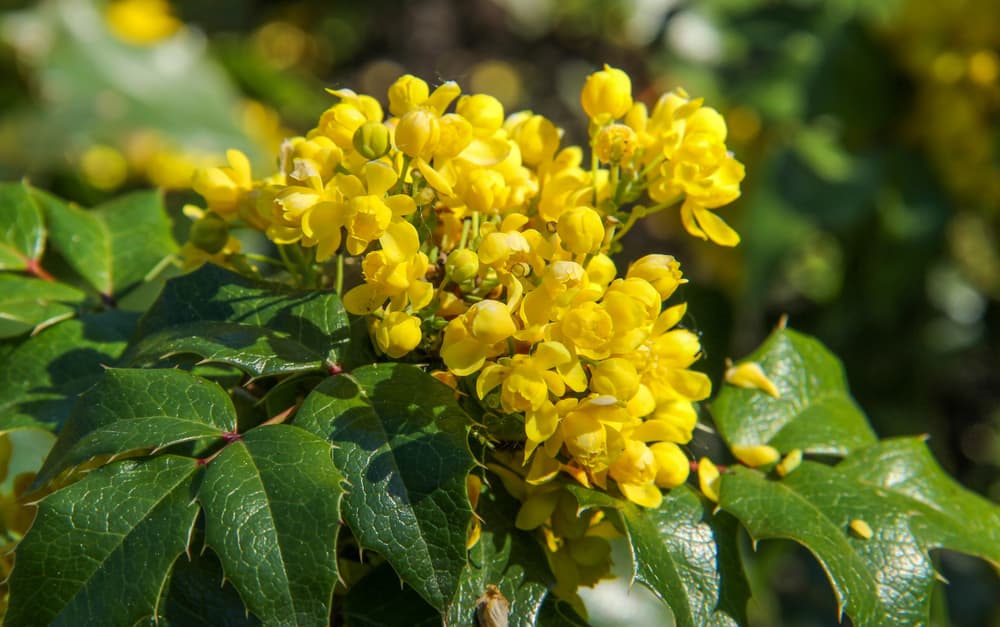
Unlike many plants, it can thrive in an exposed location, providing it isn’t subjected to freezing winds – so you can position it almost anywhere in your garden.
Soil Requirements
It isn’t too fussy about soil type either and can grow well in sand, clay, chalk or loamy soil, and all pHs.
The soil should be kept moist, but well-drained.
Mahonia can withstand temperatures down to -15°C, but it is still a good idea to mulch the soil before winter (around September time), to help protect the roots from frost.
Propagation
If you know someone with an existing Mahonia, another way to acquire new plants is through propagation.
The best time to propagate Mahonia is usually in late summer or early autumn, prior to flowering.
You can do this easily by taking semi-ripe cuttings from the plant.
Prepare for propagation by pruning hard in spring, to ensure plenty of new growth.
When it comes to making your cuttings, choose healthy, horizontal shoots from the current season, with short gaps between the leaves.

Use sharp secateurs to make cuttings of approximately 15cm, just below the leaf node.
Propagate in the morning, to prevent wilting.
Once you’ve taken the cutting, keep it cool, and aim to plant it within 12 hours.
Dip the base of the cutting in rooting hormone powder, and plant in pots filled with a mix of potting compost and sharp sand.
Place in a greenhouse or cover with plastic indoors to keep warm.
Keep the soil moist, but well-drained, and regularly remove any dead material, to prevent mould.
Common Problems
There are not many diseases and pests common to the Mahonia plant.
Powdery Mildew
One possible problem to watch out for is powdery mildew, which will cause brown spots and a grey powdery fungus to develop on the underside of leaves.
Help to avoid this by watering the soil, not the leaves of your shrub, and keeping it in a sunny location.
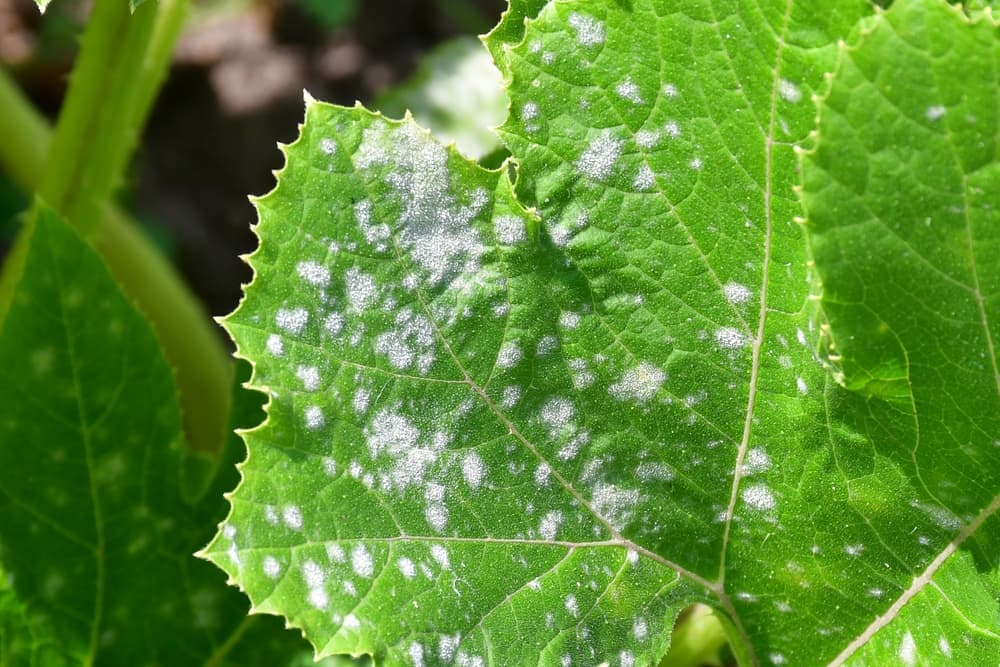
If it develops anyway, you can treat it with a fungicide.
Rust
Another potential problem to watch out for is rust.
This is more common in certain varieties, including M. aquifolium.
Rust will manifest itself as deep red, brown and black pustules on your plant, particularly on the lower leaf surface, which can reduce your plant’s vigour.
Help to prevent rust by removing all dead leaves and material after the growing period and pruning dense branches to ensure air can circulate through your plant.

If caught early, you can tackle it by removing the affected leaves as soon as they appear – if not, you may need to apply a fungicide.
Legginess
The main problem commonly encountered by growers of Mahonia is that the base of the plant becomes ‘leggy’ (bare and woody), whilst the foliage is concentrated at the top.
If your Mahonia becomes leggy, prune several branches completely to allow more light to access the base, and prune any branches with leaves at the end back to around 30cm.
Remove several branches completely, to allow more light to reach the base of the plant.
This should encourage new leaf growth.
FAQs
How Tall Does Mahonia Grow?
How tall your Mahonia will grow depends on the variety.
M. japonica will grow to around 2m tall, whilst M. x media can reach 5m.

There are smaller growing varieties, such as M. aquifolium, which will reach approximately 1.5m and others that can be used for ground cover, which peaks at around 30cm.
Bear in mind that it can take 10–20 years for a Mahonia to achieve its ultimate height.
Can Mahonia Be Grown In Pots?
Mahonia is not generally considered suitable to be grown in pots – it grows best planted directly in the ground, with plenty of space around for it to spread.

As the plant is hardy down to temperatures of -15°C, you do not need to worry about moving it inside over winter.
References
- 1Colin, O., Hinsinger, D., & Strijk, J. (2021, January 27). Mahonia lancasteri (Berberidaceae), a new species originating from Sichuan (China) described from cultivation. Phytotaxa. Retrieved March 21, 2023, from https://www.biotaxa.org/Phytotaxa/article/view/phytotaxa.482.1.5
- 2Mahonia. (n.d.). Royal Horticultural Society. Retrieved March 21, 2023, from https://www.rhs.org.uk/plants/mahonia
- 3Oregon State symbols. (n.d.). Oregon Encyclopedia. Retrieved March 21, 2023, from https://www.oregonencyclopedia.org/articles/oregon_state_symbols/#.ZBmm3uzP30o
- 4Teeling, C. (2022). Mahonia aquifolium (Oregongrape). CABI Compendium. https://doi.org/10.1079/cabicompendium.32269


